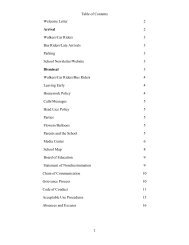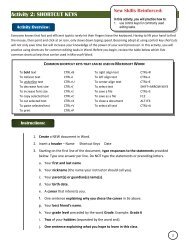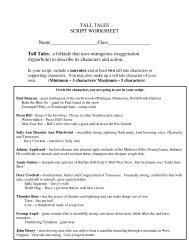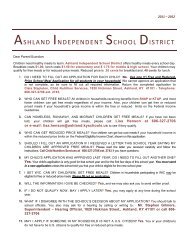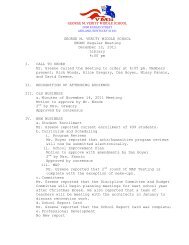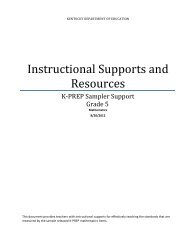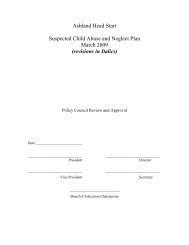Ashland Head Start Plan For Achieving Positive Child Outcomes
Ashland Head Start Plan For Achieving Positive Child Outcomes
Ashland Head Start Plan For Achieving Positive Child Outcomes
Create successful ePaper yourself
Turn your PDF publications into a flip-book with our unique Google optimized e-Paper software.
<strong>Ashland</strong> <strong>Head</strong> <strong>Start</strong><strong>Plan</strong> <strong>For</strong> <strong>Achieving</strong> <strong>Positive</strong> <strong>Child</strong> <strong>Outcomes</strong>February 2010(Revisions in Italics)Policy Council Review and ApprovalDate: _________President: _______________________Vice President: ___________________Secretary: ____________________Director: _____________________Board of Education _________________________________1
Table of ContentsProgram DescriptionProgram PhilosophyThe <strong>Child</strong> <strong>Outcomes</strong> InitiativeCurriculum Selection and ImplementationScreening and <strong>Child</strong> Assessment SystemTraining <strong>Plan</strong>Family Involvement in <strong>Child</strong>ren’s ProgressCollection of <strong>Child</strong> <strong>Outcomes</strong> DataSynthesis of <strong>Child</strong> <strong>Outcomes</strong> DataAnalysis of <strong>Child</strong> <strong>Outcomes</strong> DataOngoing MonitoringUse of <strong>Child</strong> <strong>Outcomes</strong> Data ResultsReporting Data ResultsIntegration of the <strong>Child</strong> <strong>Outcomes</strong> Initiative into Program Self-AssessmentIntegration of the <strong>Child</strong> <strong>Outcomes</strong> into the Program’sManagement Systems2
<strong>Ashland</strong> <strong>Head</strong> <strong>Start</strong>Program Description<strong>Ashland</strong> <strong>Head</strong> <strong>Start</strong> is a blended preschool program located in <strong>Ashland</strong>,Ky. Federal <strong>Head</strong> <strong>Start</strong> funding is blended with State Preschool funding inorder to provide a range of preschool services in the areas of education andearly childhood development, medical, dental, mental health, nutrition, andparent involvement for our children. Families are given support as the primarycare takers and decision makers of their children. Comprehensive and highquality services are provided to foster healthy development in children andfamilies.•Target Population: Economically disadvantaged (at-risk) children andchildren with disabilities•Services Provided: Half day comprehensive preschool services four daysper week during the <strong>Ashland</strong> Independent School calendar year.•Total Classrooms: Half day: 9•Student-teacher ratio: 17 to 3 or 17 to 2 (half day 4 year olds)15 to 3 or 15 to 2 (half day 3 year olds)•Duration: 130 days of classes per calendar year•Teacher qualifications:o Masters Degree in Early <strong>Child</strong>hood or Related Field: 2o Bachelors Degree in Early <strong>Child</strong>hood:1o Associate Degree in Early <strong>Child</strong>hood: 33
<strong>Ashland</strong> <strong>Head</strong> <strong>Start</strong> Philosophy<strong>Ashland</strong> <strong>Head</strong> <strong>Start</strong> is a federally and state blended programproviding preschool children with comprehensive services to meettheir educational, emotional, social, health, nutritional andpsychological needs.<strong>Ashland</strong> <strong>Head</strong> <strong>Start</strong> Mission StatementThe mission of the <strong>Ashland</strong> <strong>Head</strong> <strong>Start</strong> program is to create andsupport a safe and caring place to promote success for children,families and staff, meeting and exceeding the national and state goalsof <strong>Head</strong> <strong>Start</strong> and State Preschool through parent and communitypartnerships.4
<strong>Child</strong> <strong>Outcomes</strong> InitiativeOn 08.10.00, the Administration for <strong>Child</strong>ren, Youth and Families issuedan information memorandum (ACYF-IM-HS-00-18) on the subject of usingchild outcomes in program self – assessment. The IM addresses specificsteps for incorporating child outcomes data in program self-assessment,recommendations for implementing these steps, and forthcoming resourcesfor program self-assessment.In response to this IM, <strong>Ashland</strong> <strong>Head</strong> <strong>Start</strong> has focused on the goal ofenhancing program self assessment by incorporating child outcomes data andanalyzing individual children’s data and progress. A system of ongoingassessment has been developed based on <strong>Head</strong> <strong>Start</strong> <strong>Child</strong> <strong>Outcomes</strong> andKentucky’s Early <strong>Child</strong>hood Standards. Data is analyzed on individualchildren with parent input at least three times throughout the program year(not including initial home visit or parent conference). Classroom teachersutilize this data for classroom planning as well as individualization strategiesfor all children. Program data analysis takes place at least three times duringthe program year and is incorporated into the program self- assessment.Policy Council is involved in the self-assessment process and results arereported to the Policy Council and Governing Board (Board of Education).A program improvement plan or strategic plan is developed for theupcoming program year as a result of self-assessment data.The following Written <strong>Child</strong> <strong>Outcomes</strong> plan is a detailed description of<strong>Ashland</strong> <strong>Head</strong> <strong>Start</strong>’s approach to incorporating <strong>Head</strong> <strong>Start</strong> <strong>Child</strong> <strong>Outcomes</strong>and Kentucky’s Early <strong>Child</strong>hood Standards into ongoing assessment,curriculum development, data collection, reporting children’s progress, andprogram self assessment.5
I. Curriculum Selection and Implementation:As a result of Kentucky’s KIDS NOW initiative, the Building A StrongFoundation for School Success: Kentucky’s Early <strong>Child</strong>hood ContinuousAssessment Guide was completed. This manual provides guidance to earlychildhood programs regarding appropriate methods and instruments forassessing children in Kentucky. Preschool programs in Kentucky arerequired to select an assessment instrument from the list of recommendedtools.<strong>Ashland</strong> <strong>Head</strong> <strong>Start</strong> / Preschool Program instructional staff attendedtraining and reviewed assessment tools in May 2006. After reviewingcurriculum and assessment instruments, staff made the decision to conduct astudy on the Creative Curriculum and obtain parent input into adopting anew curriculum and assessment tool. During the 2006-2007 school year,staff obtained further information and parents were provided an opportunityto look at the instruments during a parent committee meeting. In the Springof 2007, staff and parents (policy council approval) made the decision toimplement the Creative Curriculum and Creative Curriculum.net onlineassessment system during the 2007-2008 school year.II. Screening and <strong>Child</strong> Assessment System:A. Diagnostic Screening and Assessment:<strong>Ashland</strong> <strong>Head</strong> <strong>Start</strong> uses the Learning Accomplishment Profile –Diagnostic (LAP-D) Screen to screen children’s development in the areas ofcognition, motor, and language. This open screening is conducted before theprogram year begins and all children are screened within 45 days ofenrollment. Follow – up with diagnostic assessment using the LearningAccomplishment Profile – Diagnostic is conducted with parent permissionon those children scoring at or below the cut off score on the LAP-D screen.The LAP-D is a standardized assessment of children’s development in theareas of cognition, motor, and language. Assessment results are used to7
determine eligibility for specially designed instruction. (See DisabilityService <strong>Plan</strong>)B. On-going Assessment:<strong>Ashland</strong> <strong>Head</strong> <strong>Start</strong> uses Creative Curriculum.net online assessment tomonitor the ongoing assessment of children’s progress. <strong>Head</strong> <strong>Start</strong> <strong>Child</strong><strong>Outcomes</strong> are measured using the Creative Curriculum.net onlineassessment.Educational staff collects data sources on children, documenting evidenceof progress. Data sources include parent input, developmental screens,diagnostic assessment, observations, work samples, and photographs. Oncechildren have achieved a stage of development, a developmental step isselected on the Creative Curriculum.net online assessment. Parent input isobtained at the beginning of the program year for developingindividualization strategies and baseline assessment. Progress reports arecompiled and given to parents three times throughout the program yearduring home visits / parent conferences. Discussion takes place betweeneducational staff and parents, resulting in individualization strategies basedon individual assessment results and input into the curriculum for that child.Classroom activities are planned based on Creative Curriculum.net onlineassessment data, individualization strategies and curriculum input fromparent. (See Early <strong>Child</strong>hood Development <strong>Plan</strong> and Literacy <strong>Plan</strong>)III. Training <strong>Plan</strong>:Staff training is provided on an ongoing basis in the areas specific tocurriculum, ongoing assessment, and diagnostic assessment. Staff is trainedin early childhood development, LAP-D screening and assessment, CreativeCurriculum, and Creative Curriculum.net online assessment. Training takesplace during noninstructional days and preservice training. Training isprovided at local and regional levels, using <strong>Head</strong> <strong>Start</strong> staff and <strong>Ashland</strong>Regional Training Center staff when applicable. Daily support and trainingfollow up is provided within the classroom environments by Director and8
the computer based on data sources collected. Data collection and data entryare ongoing throughout the school year. Progress reports are printed forparents three times throughout the program year. Classroom data as well aschild data are available for classroom staff to plan and individualize. Programdata are compiled three times throughout the program year and used as part ofthe program’s self assessment.VI. Synthesis of <strong>Child</strong> <strong>Outcomes</strong> Data:Creative Curriculum.net online assessment will synthesize all child,classroom and program data. <strong>Child</strong> data are housed within each child’sportfolio and used for individualizing that child’s instruction and curriculum.Classroom teachers are given access to data of children in their classes and datagenerated for their class. Classroom data are used for classroom planning andcurriculum. Center and program data can be accessed by management staff andare used for program planning. Reports are generated three times throughoutthe program year for program progress. These reports are analyzed during theprogram self-assessment and used in the development of the program’sstrategic plan.VII. Analysis of <strong>Child</strong> <strong>Outcomes</strong> Data:Classroom teachers are responsible for the analysis of individual childprogress reports and classroom progress for individualizing the curriculum andlesson planning. Teachers are gathering information / data sources throughdirect child observation on the Creative Curriculum.net online assessment.This information is used to individualize the curriculum and lesson planning.Director and Education / Disability Coordinator are responsible foranalyzing classroom progress and program data. Reports are generated threetimes throughout the program year for analysis of progress toward programgoals. These reports are discussed and analyzed during staff meetings and theprogram self-assessment and used in the development of the program’s10
strategic plan for improvement. Program strengths and weaknesses will beapparent as well as child outcomes data.VIII. Ongoing Monitoring:Classroom data collection and data entry are ongoing throughout theschool year. Lesson plans are submitted electronically by the classroomteacher to the Education and Disability Coordinator on Friday before lessonsare taught. Director and Education and Disability Coordinator monitor theimplementation of Creative Curriculum, Intentional Teaching Strategies, andIndividualization on a weekly basis. Feedback is given to teachers on anindividual basis as needed and program planning issues discussed during Fridaystaff meetings. Program reports are generated from Creative Curriculum.netonline assessment by Director and Education and Disability Coordinator threetimes throughout the program year.IX. Use of <strong>Child</strong> <strong>Outcomes</strong> Data Results:Classroom teachers use Creative Curriculum.net online assessmentclassroom reports to analyze classroom and child progress on the <strong>Child</strong><strong>Outcomes</strong>. This information is used to individualize and modify classroomcurriculum / activities according to results. Director and Education andDisability Coordinator use child outcomes data to analyze classroom, center,and program progress on <strong>Child</strong> <strong>Outcomes</strong>. This analysis is used to makeadjustments to current instructional methods used in classes, currentimplementation of Creative Curriculum, and training plans for educationalstaff. Program data are used during the Program Self Assessment and forplanning of program’s long and short-term objectives included in the strategicand training and technical assistance plans.X. Reporting Data ResultsCreative Curriculum.net online assessment reports are generated onindividual children’s progress at a minimum of three times per program year.11
These reports are shared with parents during a home visit / parent conferenceand parents are given copies of the report. Results are discussed with parents,individualization goals are developed with parent input, and adjustments madeto curriculum for each child. Program reports are generated by Director andEducation and Disability Coordinator from Creative Curriculum.net onlineassessment three times throughout the program year to analyze programprogress on <strong>Child</strong> <strong>Outcomes</strong> Data.Individual child progress reports are shared with parents three timesthroughout the program year during home visit / parent conferences. Progressis discussed with the parent and plans developed for the child’s next programyear during the final conference. Parents are given copies of CreativeCurriculum.net online assessment reports and results are passed on to thechild’s next teacher in kindergarten with parental permission or <strong>Head</strong> <strong>Start</strong> forreturning children. Program data results are reported to the self-assessmentcommittee to be used in planning for the next program year.XI. Integration of the <strong>Child</strong> <strong>Outcomes</strong> Initiative into ProgramSelf-Assessment:<strong>Child</strong> <strong>Outcomes</strong> data are integrated into the Program Self Assessment atthe end of the program year. Creative Curriculum.net online assessmentreports are generated on classroom and program progress on the child outcomesthree times throughout the program year. The Self Assessment committeeanalyzes the data and a program strategic plan, including long and short termobjectives, is developed for the upcoming school year based on program dataresults.XII. Integration of the <strong>Child</strong> <strong>Outcomes</strong> Initiative into theProgram’s Management Systems<strong>Child</strong> <strong>Outcomes</strong> data is analyzed at classroom and program levels usingthe Creative Curriculum.net online assessment. Program Director andEducation and Disability Coordinator monitor progress on <strong>Child</strong> <strong>Outcomes</strong> and12
Strategic <strong>Plan</strong> by generating various Creative Curriculum.net online assessmentreports designed for program management and monitoring. These reports aregenerated at a minimum of three times throughout the program year. Programand classroom modifications and staff training are provided as a result of thesereports and the Training and Technical Assistance <strong>Plan</strong>, incorporating <strong>Child</strong><strong>Outcomes</strong> into the program’s system of curriculum and ongoing assessment.13



